 ollowing
the trail through the woods
ollowing
the trail through the woods
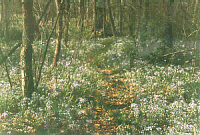 at Farmer Melanie’s farm, the biology students noticed a large variety of
organisms all living together in the same habitat. Of course, numerous trees
were visible, but the students also saw many wildflowers and mushrooms under
the trees. There were insects “everywhere.” As the students watched, a bird
swooped down and gobbled up a caterpillar that, just moments before, had been
eagerly chomping on a leaf, but then, a few minutes later, that bird dove for
cover as a hawk soared overhead. Later, some of the young children who were
present enjoyed picking Japanese Beetles off the raspberry bushes and
throwing them to the chickens, who rapidly ate the beetles like they were
candy. And then, of course, the ants found the picnic
table.
at Farmer Melanie’s farm, the biology students noticed a large variety of
organisms all living together in the same habitat. Of course, numerous trees
were visible, but the students also saw many wildflowers and mushrooms under
the trees. There were insects “everywhere.” As the students watched, a bird
swooped down and gobbled up a caterpillar that, just moments before, had been
eagerly chomping on a leaf, but then, a few minutes later, that bird dove for
cover as a hawk soared overhead. Later, some of the young children who were
present enjoyed picking Japanese Beetles off the raspberry bushes and
throwing them to the chickens, who rapidly ate the beetles like they were
candy. And then, of course, the ants found the picnic
table.
Ecology
Ecology is the study of the relationships between (or
interrelations among) living organisms and their environment. This
includes physical factors such as the amount of heat, light, oxygen, etc.,
as well as non-living objects such as rocks and water which are present in
the environment, in addition to interactions with and among living organisms
of the same species and of other species. So often, in the popular press,
the word “ecology” is used where something like “environmental studies”
might be a more appropriate term. Ecology is not just studying human
influence (good or bad) on the environment, but rather looks at the totality
of what’s going on in that environment. Ecology studies populations
of the same organism, communities of different species living together
in the same habitat, ecosystems which are comprised of the living
organisms plus the non-living factors and objects in an environment, and
finally, the biosphere, that “layer” of living organisms surrounding
planet Earth, together with all their
interactions.
Many of the non-living factors in an ecosystem occur in
cyclical patterns. For example, plants absorb energy from sunlight and take
in carbon dioxide (CO2) from the air, then use that energy to
convert the CO2 to sugar, then also to proteins, fats, and other
molecules. Animals eat those plants, then burn some of the sugar for fuel,
thereby releasing some of the CO2 back into the air. Some of the
carbon thus ingested is incorporated into the animal’s body, and if another,
larger animal feeds on that one, the carbon-containing compounds may be
incorporated into that animal’s body, etc. Eventually, they all die, and as
decomposers (organisms like earthworms and mushrooms) break down the dead
tissue, much of the remaining carbon is, once again, released into the
atmosphere as CO2, and the cycle starts over, again. Factors
such as temperature and light also go through cycles. We can study the
influence of both daily and yearly light cycles on the organisms within an
environment.
There is a wide variety of habitats here on earth, even
here in the greater Cincinnati area. For example, aquatic habitats include
the fresh-water lake, river, and stream habitats found around here as well
as costal, open water, and deep sea habitats in the ocean. Marshes are
grassy wetlands and swamps are wooded wetlands. Terrestrial habitats include
a number of types of forest areas, shrubland areas, grassland areas (some
naturally-occurring, others man-made), tundra, and desert, just to list a
few.
Ecology also studies the changes in the make-up of a
community or ecosystem over time. For example, when they built the new
buildings at the college, there was a lot of bare soil around. Given an
opportunity, the first, colonizing plants like dandelions started to grow
there, which enabled more, other plants to grow there, which enabled yet
another batch of plants that need a bit more shelter to grow there, etc.,
until, if left alone, eventually the area would return to a forest.
In other areas of the world, that process works differently. For example,
if a portion of tropical rainforest is destroyed, either for farmland or
because of logging activity, that cut area will not return to rainforest,
which consists of tall trees with little understory, but rather grow up as
jungle, which is an impenetrable tangle of vines and other lush
growth.
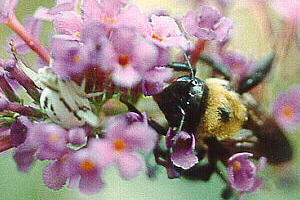 Ecology studies interactions among organisms. This includes
everything from mating behavior and care of the young to the behavior of
predators and their prey. Defense mechanisms such as camouflage are also
included. While this bumblebee is probably too big for this crab spider,
the spider is well camouflaged while waiting for “dinner” to land on these
flowers.
Ecology studies interactions among organisms. This includes
everything from mating behavior and care of the young to the behavior of
predators and their prey. Defense mechanisms such as camouflage are also
included. While this bumblebee is probably too big for this crab spider,
the spider is well camouflaged while waiting for “dinner” to land on these
flowers.
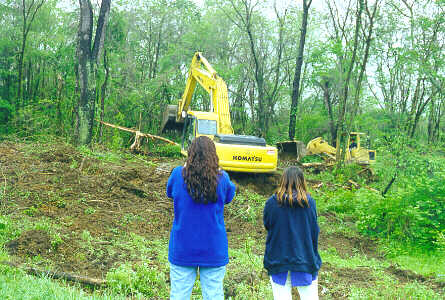 And, yes, since humans are part of the local environment,
ecology does also study the effects that the human species has on the
environment. Here are photos of some Clermont Ecology students watching
as an area of the campus woods is being destroyed, then after the workmen
left for lunch, going in to rescue the remains of a large Christmas Fern.
And, yes, since humans are part of the local environment,
ecology does also study the effects that the human species has on the
environment. Here are photos of some Clermont Ecology students watching
as an area of the campus woods is being destroyed, then after the workmen
left for lunch, going in to rescue the remains of a large Christmas Fern.

Background Information
Links to Related Information on Our Web Server
The following Web pages contain information related to
Ecology.
- Bio Lecture Photosynthesis
- Information on the process by which plants turn sunlight into food for everyone
- Bio Lecture Coevolution and Pollination
- Information on organisms which have evolved totally dependent on each other, especially pollinator-pollination relationships
- Bio Lecture Ecology
- General Information on a variety of ecological topics
- Bio 116 Worm Bin Activity
- Instructions for setting up a worm bin in a 2-liter bottle
- Ecology Web pages
- A link to the main Web page for our sophomore Ecology course — click on “class notes” to view the various topics
Your Assignment
A Scavenger Hunt
There will be one, combined assignment for the topics of
Taxonomy, Evolution, Ecology, and Human Intervention. Thus, even though
this will appear on each of those pages to remind you, you only need to do it
once. You will need to go somewhere where there are lots of living
organisms. Assuming you’re here in the Cincinnati area, you might go (with
your family?) to the Cincinnati Zoo, Krohn Conservatory, the Newport Aquarium,
one of the local parks, or someplace similar to that. If you’re not in the
Cincinnati area, there are probably similar places to visit near wherever
you are. However, if finances are tight and/or you’re short on time, your
back yard would work, too! Then, you need to try to find organisms in as
many taxonomic groups/categories as possible. You need to observe and take
notes on each organism you find — you do not need to try to catch them or
pick them up, but rather, observe their natural behavior — then go look up
further information on each of those organisms.
The grading criteria for this assignment are given below, and you should also
refer to those as you work on the assignment.
A total of 26 points is possible.
- Kingdoms: Finding organisms in Kingdoms Fungi, Plantae, and
Animalia should be fairly easy. If you look in just the right place, you
might also be able to see some of the larger organisms from Kingdom
Protista. You probably will not be able to see any of the organisms in
Kingdom Monera without a microscope.
- Phyla (Divisions): Figuring out to what phylum (botanists use the
word “division” instead of “phylum”) organisms in Kingdoms Protista and
Fungi belong would be difficult, but there are a number of Phyla/Divisions
in Kingdoms Plantae and Animalia that are fairly easy to identify. These
includethe following.
Within Kingdom Plantae it should be fairly easy to find representatives of
- Division Bryophyta
- Division Pterophyta
- Division Gymnospermae
- Angiospermae/Division Monocotyledones
- Angiospermae/Division Dicotyledones
plus, if you are fortunate enough to be in just the right place, you may see
representatives of Division Lycophyta or Division Sphenopytya.
Within Kingdom Animalia, you can probably find representatives of
- Phylum Mollusca
- Phylum Annelida
- Phylum Arthropoda
- Phylum Chordata, Subphylum Vertebrata
plus, if you go to the Aquarium or the Zoo, you may also be able to find
representatives of Phylums Porifera, Cnidaria/Coelenterata, and/or
Echinodermata.
- Phylum Arthropoda: Finding members of the following classes
is possible, but you probably will not find representatives of all of
these groups at once unless you are able to go somewhere like the Insect
World at the Zoo. These include
- Class Arachnida
- Class Crustacea (Malacostraca)
- Class Diplopoda
- Class Chilpopda
- Class Insecta
plus, if you are able to go to the Zoo or the Aquarium, you might also
be able to find members of Class Xiphosura.
- Phylum Chordata, Subphylum Vertebrata: If you’re using your
back yard, several of these might be difficult to find if you live in an
urban area, but in general, the possibilities include
- Class Osteichthyes (possible in/near your yard if you live near
a body of water, but more likely at the Zoo or the Aquarium)
- Class Amphibia
- Class Reptilia
- Class Aves
- Class Mammalia
plus if you are able to go to the Zoo or Aquarium, you can probably also see
members of Class Chondrichthyes.
- Note that because the taxonomic heirarchy is “nested,” a given organism
may represent several taxa. For example, a cat would represent Kingdom
Animalia, Phylum Chordata–Subphylum Vertebrata, and Class Mammalia.
Also, note that you will only get credit for organisms that are correctly
placed — for example, credit would not be given for a domestic dog listed
as a plant.
- For as many as possible of the organisms you find, look up and include
their scientific names. The
list of species seen
on campus may be of help. Do not expect to find scientific names for
everything you see. For example, there are so many kinds of flies that look
so similar, it takes a PhD to identify them to species, but if you would
see something like a Monarch butterfly, that species name is “easy” to
find.
- For each organism, take notes on their characteristics: what do they
look like, do they have any “unusual” body parts, what are they doing,
how do they move, etc.
- Describe the habitat/environment in which each organism is found. If
you’re at the Zoo, Aquarium, etc., these habitats may be very different, but
if you’re in your back yard, it may seem, at first glance, like all the
same habitat. Look more carefully, then — for example, the habitat in a
flower bed would be different than the habitat in the middle of a lawn area.
Notice (and take notes on) the amount of light (shady under trees and plant
leaves vs bright sun in open lawn area), temperature/heat (cooler under trees,
really cold in a penguin exhibit at the Zoo), humidity, soil conditions, etc.
in the organism’s environment.
- Describe the organisms’ interactions with other organisms that share
their habitats: what do they eat or how do they get food, who eats them,
how do they defend themselves from predators (chemical defenses, camouflage,
teeth and claws, or whatever). Do you see anything that looks like mating
behavior? If they eat food, how do they eat their food (chew it up, suck
it up, etc.)? How do they communicate with other members of their species
and with other organisms? Are they solitary organisms or do they typically
live in a social group such as a colony or pack? What is each organism’s
“job” within its environment — what does it do there? Do you see any other
interesting behavior patterns?
- Describe how human intervention, “good” or “bad,” has influenced each
organism and its environment. For captive organisms, you may wish to
consider both their normal, natural environment as well as the artificial
or display environment in which they are currently living. Is there anything
that we could/should be doing to improve and/or properly manage those
environments?
- At this point, if you are a registered student, you should
submit your work.
Grading Criteria
| 1. Taxonomy: |
|---|
| 2 | — | Representatives of 4(+) kingdoms were included |
| 1 | — | Representatives of 2-3 kingdoms were included |
| 0 | — | Representatives of only 1 kingdom were included |
 |
|---|
| 2 | — | Representatives of 4(+) plant divisions were included |
| 1 | — | Representatives of 2-3 plant divisions were included |
| 0 | — | Representatives of only 0-1 plant division were included |
 |
|---|
| 2 | — | Representatives of 4(+) animal phyla were included |
| 1 | — | Representatives of 2-3 animal phyla were included |
| 0 | — | Representatives of only 0-1 animal phylum were included |
 |
|---|
| 2 | — | Representatives of 4(+) arthropod classes were included |
| 1 | — | Representatives of 2-3 arthropod classes were included |
| 0 | — | Representatives of only 0-1 arthropod class were included |
 |
|---|
| 2 | — | Representatives of 4(+) vertebrate classes were included |
| 1 | — | Representatives of 2-3 vertebrate classes were included |
| 0 | — | Representatives of only 0-1 vertebrate class were included |
 |
|---|
| 2 | — | 11 or more total organisms were included |
| 1 | — | 6-10 total organisms were included |
| 0 | — | 5 or less total organisms were included |
 |
|---|
| 2 | — | 5(+) scientific names were included |
| 1 | — | 2-4 scientific names were included |
| 0 | — | 0-1 scientific names were included |
| 2. Ecology: |
|---|
| 2 | — | Descriptions of the organisms’ traits/characteristics were thorough and showed that the student was extremely observant |
| 1 | — | Descriptions of the organisms’ traits/characteristics were adequate and showed that the student was fairly observant |
| 0 | — | Descriptions of the organisms’ traits/characteristics were too sketchy and showed that the student wasn’t very observant |
 |
|---|
| 2 | — | Descriptions of the organisms’ habitat and environmental conditions were thorough and showed that the student was extremely observant |
| 1 | — | Descriptions of the organisms’ habitat and environmental conditions were adequate and showed that the student was fairly observant |
| 0 | — | Descriptions of the organisms’ habitat and environmental conditions were too sketchy and showed that the student wasn’t very observant |
 |
|---|
| 2 | — | Descriptions of the organisms’ interactions and behaviors were thorough and showed that the student was extremely observant |
| 1 | — | Descriptions of the organisms’ interactions and behaviors were adequate and showed that the student was fairly observant |
| 0 | — | Descriptions of the organisms’ interactions and behaviors were too sketchy and showed that the student wasn’t very observant |
 |
|---|
| 2 | — | Descriptions of the human impact on these organisms’ environments were thorough and showed that the student was extremely observant and thoughtful |
| 1 | — | Descriptions of the human impact on these organisms’ environments were adequate and showed that the student was fairly observant and thoughtful |
| 0 | — | Descriptions of the human impact on these organisms’ environments were too sketchy and showed that the student wasn’t very observant and/or gave little evidence of putting much thought into it |
| 3. Overall: |
|---|
| 2 | — | The student, obviously, went beyond the minimum requirements of the assignment |
| 1 | — | The student adequately completed the assignment |
| 0 | — | The student completed considerably less of the assignment than what was required |
 |
|---|
| 2 | — | It is evident that the student used much insight, thoughtfulness, and critical thinking when completing this assignment |
| 1 | — | The student adequately thought about the assignment – there was, perhaps, a bit of “fuzzy thinking” in a couple places |
| 0 | — | The assignment gives the appearance of being “slapped together” just to get it done, with little evidence of thoughtfulness |
| Total Possible: |
|---|
| 26 | — | total points |
Copyright © 2006 by J. Stein Carter. All rights reserved.
This page has been accessed  times since 18 Nov 2006.
times since 18 Nov 2006.
 ollowing
the trail through the woods
ollowing
the trail through the woods
 at Farmer Melanie’s farm, the biology students noticed a large variety of
organisms all living together in the same habitat. Of course, numerous trees
were visible, but the students also saw many wildflowers and mushrooms under
the trees. There were insects “everywhere.” As the students watched, a bird
swooped down and gobbled up a caterpillar that, just moments before, had been
eagerly chomping on a leaf, but then, a few minutes later, that bird dove for
cover as a hawk soared overhead. Later, some of the young children who were
present enjoyed picking Japanese Beetles off the raspberry bushes and
throwing them to the chickens, who rapidly ate the beetles like they were
candy. And then, of course, the ants found the picnic
table.
at Farmer Melanie’s farm, the biology students noticed a large variety of
organisms all living together in the same habitat. Of course, numerous trees
were visible, but the students also saw many wildflowers and mushrooms under
the trees. There were insects “everywhere.” As the students watched, a bird
swooped down and gobbled up a caterpillar that, just moments before, had been
eagerly chomping on a leaf, but then, a few minutes later, that bird dove for
cover as a hawk soared overhead. Later, some of the young children who were
present enjoyed picking Japanese Beetles off the raspberry bushes and
throwing them to the chickens, who rapidly ate the beetles like they were
candy. And then, of course, the ants found the picnic
table. 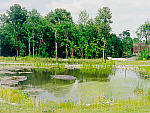

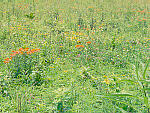

 Ecology studies interactions among organisms. This includes
everything from mating behavior and care of the young to the behavior of
predators and their prey. Defense mechanisms such as camouflage are also
included. While this bumblebee is probably too big for this crab spider,
the spider is well camouflaged while waiting for “dinner” to land on these
flowers.
Ecology studies interactions among organisms. This includes
everything from mating behavior and care of the young to the behavior of
predators and their prey. Defense mechanisms such as camouflage are also
included. While this bumblebee is probably too big for this crab spider,
the spider is well camouflaged while waiting for “dinner” to land on these
flowers.  And, yes, since humans are part of the local environment,
ecology does also study the effects that the human species has on the
environment. Here are photos of some Clermont Ecology students watching
as an area of the campus woods is being destroyed, then after the workmen
left for lunch, going in to rescue the remains of a large Christmas Fern.
And, yes, since humans are part of the local environment,
ecology does also study the effects that the human species has on the
environment. Here are photos of some Clermont Ecology students watching
as an area of the campus woods is being destroyed, then after the workmen
left for lunch, going in to rescue the remains of a large Christmas Fern.
